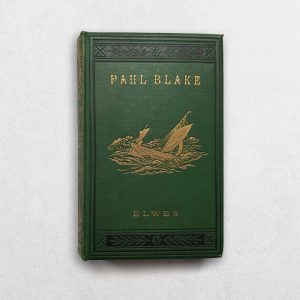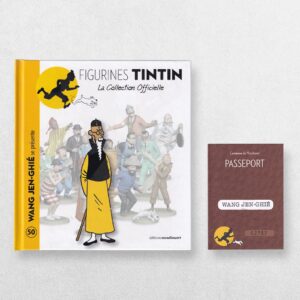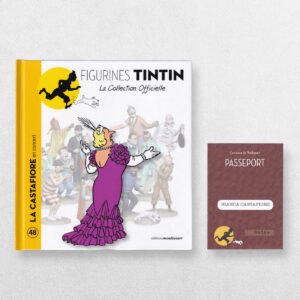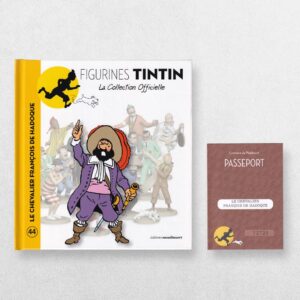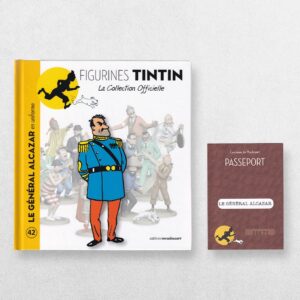Professor Decimus Phostle Calys Triumphant – Figurines Tintin La Collection Officielle – 52 – Le Professeur Calys Triomphant
Hergé & Editions Moulinsart
£60.00
Availability: In stock
Product Description
Professor Decimus Phostle Calys Triumphant – Figurines Tintin La Collection Officielle – 52 – Le Professeur Calys Triomphant
Author: Hergé & Editions Moulinsart
Price: £60.00
Publisher: Editions Moulinsart
Publication date: 2013
Format: Original pictorial boards with passport and figurine
Condition: In near fine condition
Illustrations: Illustrated throughout
Description:
Original pictorial boards. Includes passport loosely inserted. Text in French. Includes the accompanying figurine. One from the collection of 111 books and figurines. Very slight wear. In very near fine, clean condition overall.
Professor Calys: A Short Biography
Professor Decimus Phostle Calys — often referred to simply as Professor Calys — is a distinguished yet delightfully absent-minded astronomer who appears in The Shooting Star (L’Étoile mystérieuse, first published in 1942). A brilliant scientist with a passionate curiosity about the cosmos, he embodies both the intellectual excitement and the human eccentricity of Hergé’s scientific characters.
Although his role is limited to a single Tintin adventure, Calys is a vivid and memorable presence whose mixture of academic brilliance and gentle absurdity sets the tone for much of the story.
Character Overview
Professor Calys is portrayed as a learned astronomer working at an observatory in a European country (left deliberately unspecified by Hergé, as was his custom). He is the head of the observatory’s scientific team and the first to detect the approach of a strange celestial body — a glowing new star that appears to be on a collision course with Earth.
His discovery sets the plot of The Shooting Star in motion, transforming what begins as a story of cosmic dread into one of scientific exploration and moral tension.
Physically, Calys is drawn in Hergé’s classic style: balding, bearded, bespectacled, and slightly rotund, with an air of distracted enthusiasm. His gestures are expressive, his speech animated, and his manner utterly unpretentious — a man more interested in discovery than decorum.
Role in The Shooting Star
At the story’s opening, Professor Calys and his team observe a newly visible star that appears to be approaching Earth. As calculations confirm the star’s alarming trajectory, Calys reacts not with panic but with fascination. His scientific excitement contrasts sharply with the hysteria that grips others — including Professor Philippulus, a fellow astronomer who descends into madness and begins preaching apocalypse.
When it becomes clear that the celestial body will narrowly miss Earth, Calys leads an international expedition to recover a fragment of the meteorite that has fallen into the Arctic Sea. This fragment, later found to contain a previously unknown metal, becomes the object of fierce competition between two rival scientific teams — one representing Europe, led by Calys, and another financed by a corrupt industrialist, Mr Bohlwinkel, from a fictional rival nation.
Calys invites Tintin and Captain Haddock to join his expedition aboard the ship Aurora. Tintin’s courage and initiative prove vital to the mission’s success, as the team faces sabotage, danger, and natural peril before ultimately discovering the meteorite.
Personality and Traits
Professor Calys is one of Hergé’s most endearing scientist figures. His personality combines intellect, enthusiasm, and gentle eccentricity:
- Brilliant but absent-minded: He is deeply absorbed in his research, often overlooking social conventions or practical details.
- Enthusiastic: His excitement over discovery gives the story warmth and energy.
- Kind and unworldly: He shows no interest in politics, money, or fame, caring only for scientific truth.
- Courageous through curiosity: While not physically brave, his intellectual daring is a form of moral courage.
Calys stands as a benign counterpart to more sinister or misguided scientists in the Tintin canon — such as Professor Philippulus (whose intellect turns to madness) or Dr Müller (who uses science for cruelty).
Symbolism and Themes
Through Professor Calys, Hergé explores the tension between knowledge and morality — a central theme in The Shooting Star. The professor’s pure scientific curiosity contrasts with the greed and corruption of the financiers who exploit discovery for profit.
- Science as a noble pursuit: Calys represents the best of scientific inquiry — curiosity untainted by ambition or politics.
- Human fallibility: His eccentricity and naivety remind readers that even noble minds can be vulnerable to manipulation or misunderstanding.
- Faith in reason: Amid the apocalyptic hysteria surrounding the meteor, Calys’s calm rationalism embodies Hergé’s belief in logic and human intellect as antidotes to fear.
In this sense, Calys belongs to a tradition of Hergé’s “humanist scientists” — precursors to Professor Calculus (Tryphon Tournesol) in later stories — who symbolise the union of reason, decency, and imagination.
Relationship with Tintin and Captain Haddock
Professor Calys’s relationship with Tintin is one of mutual respect and affection. Tintin admires Calys’s dedication and intellect, while Calys recognises Tintin’s bravery and practical skill. Their collaboration during the Aurora expedition reflects Hergé’s recurring ideal: the alliance of science and moral courage.
With Captain Haddock, the relationship is more humorous. Haddock finds Calys’s absent-mindedness both baffling and endearing, often responding to his bursts of enthusiasm with exasperated good humour. Their dynamic anticipates the later rapport between Haddock and Professor Calculus — a mix of admiration and comic misunderstanding.
Artistic and Narrative Importance
Visually and tonally, Professor Calys anchors The Shooting Star between realism and fantasy. His observatory, filled with telescopes and instruments, establishes an atmosphere of scientific wonder, while his expedition provides a framework for adventure.
Hergé’s artwork balances precision with warmth: the gleam of the observatory’s glass domes, the vastness of the night sky, and the ice-bound Arctic scenes all reflect the grandeur of Calys’s quest.
Cultural Context
Published during the Second World War, The Shooting Star reflects both scientific optimism and existential anxiety. Professor Calys’s quest to study the heavens contrasts with the destructive realities of war on Earth. His serene dedication to discovery becomes a symbol of hope — of humanity striving to understand rather than to conquer.
Legacy
Although Professor Calys appears only in The Shooting Star, his influence endures. He laid the groundwork for Hergé’s later depiction of scientists, particularly Professor Calculus, who would combine intellect with eccentricity in a more comedic vein.
Calys also embodies Hergé’s faith in science as a force for good — a theme that runs through later works such as Destination Moon and Explorers on the Moon. In these stories, scientific exploration becomes a moral as well as intellectual adventure.
Through Calys, Hergé suggested that knowledge, pursued with humility and integrity, is one of humanity’s purest callings.
Summary
- Full name: Professor Calys
- Profession: Astronomer and expedition leader
- First appearance: The Shooting Star (L’Étoile mystérieuse, 1942)
- Traits: Brilliant, absent-minded, kind, enthusiastic, morally upright
- Symbolism: Represents scientific curiosity uncorrupted by greed; the triumph of reason over fear
- Allies: Tintin and Captain Haddock
- Fate: Successfully leads the Aurora expedition to the fallen meteorite fragment
Conclusion
Professor Calys stands as one of Hergé’s gentlest and most idealistic creations — a man whose love of discovery reflects the brighter side of human curiosity. His triumph is not merely scientific but moral: the victory of integrity and intellect in a world threatened by hysteria and greed.
Through Calys, Hergé offered a quiet tribute to science as a noble pursuit — a light of reason shining amid the uncertainty of his time.
Why Buy from Us?
At Hornseys, we are committed to offering items that meet the highest standards of quality and authenticity. Our collection of objects and rare books are carefully curated to ensure each edition is a valuable piece of bibliographical history. Here’s what sets us apart:
- Authenticity and Provenance: Each item is meticulously researched and verified for authenticity and collation.
- Expert Curation: Our selection process focuses on significance, condition, and rarity, resulting in a collection that is both diverse and distinguished.
- Customer Satisfaction: We aim to provide an exceptional customer experience, from detailed descriptions to secure and prompt delivery of your purchase.
- Returns Policy: We offer an unconditional guarantee on every item. If you wish to return an item, it may be sent back to us within fourteen days of receipt. Please notify us in advance if you wish to do so. The item must be returned in the same condition as it was sent for a full refund.
Cataloguer: Daniel Hornsey
Daniel Hornsey has specialised in fine and rare books, ephemera, and collectors’ editions for over thirty years. As a long-standing member of the antiquarian book trade, he has advised private collectors, curated catalogues, and sourced works for leading dealers, libraries and institutions across the world.
Hornseys’ exhibit regularly at book and map fairs in London and throughout the UK and are members of the Provincial Booksellers Fairs Association, the PBFA.
His fascination with Hergé’s work — especially ‘The Adventures of Tintin’ — began in childhood. Daniel recalls reading Tintin in original European editions and quickly recognising that these were not merely children’s books, but finely illustrated narratives crafted with artistic depth and wit.
As noted by the Musée Hergé in Louvain-la-Neuve, Hergé’s ‘ligne claire’ style has influenced generations of European comic artists and his original drawings and paintings command very high prices with his painting of ‘The Blue Lotus’ jar fetching £2.8m at auction in 2021.
By presenting these works through Hornseys’, he hopes to contribute to the continued appreciation of one of the 20th century’s most influential illustrators, helping new generations discover the artistry and legacy of Hergé.
Related products
Paul Blake Or The Story Of A Boy’s Perils In The Islands Of Corsica And Monte Cristo
£125.00Elwes, Alfred (Leighton Binding)
E H Shepard, The Man Who Drew Pooh: The Story Of E H Shepard: Signed By The Author
£35.00Chandler, Arthur R
The Fairies Or The Tales Of Mother Goose Corrected Typescript: Presentation Copy To John Arlott
£275.00Disher, M Willson
You may also like…
Mr Wang Introduces Himself – Figurines Tintin La Collection Officielle – 50 – Wang Jen-Ghie Se Présente
£60.00Hergé & Editions Moulinsart
Castafiore In Concert – Figurines Tintin La Collection Officielle – 48 – La Castafiore En Concert
£45.00Hergé & Editions Moulinsart
Sir Francis Haddock – Figurines Tintin La Collection Officielle – 44 – Le Chevalier François De Hadoque
£95.00Hergé & Editions Moulinsart
General Alcazar In Uniform – Figurines Tintin La Collection Officielle – 42 – Le Général Alcazar En Uniforme
£45.00Hergé & Editions Moulinsart
Colonel Sponsz Upset – Figurines Tintin La Collection Officielle – 37 – Le Colonel Sponsz Contrarié
£55.00Hergé & Editions Moulinsart
Monsieur Boullu The Stonemason – Figurines Tintin La Collection Officielle – 35 – Monsieur Boullu Le Marbrier
£40.00Hergé & Editions Moulinsart
Haddock Alpinist – Figurines Tintin La Collection Officielle – 34 – Haddock En Alpiniste
£45.00Hergé & Editions Moulinsart
Calculus The Gardener – Figurines Tintin La Collection Officielle – 28 – Tournesol En Jardinier
£35.00Hergé & Editions Moulinsart
Haddock As Hadoque – Figurines Tintin La Collection Officielle – 24 – Haddock En Hadoque
£45.00Hergé & Editions Moulinsart
Ridgewell The Explorer – Figurines Tintin La Collection Officielle – 23 – Ridgewell L’Explorateur
£45.00Hergé & Editions Moulinsart
Tintin In Kilt – Figurines Tintin La Collection Officielle – 22 – Tintin En Kilt
£65.00Hergé & Editions Moulinsart
King Muskar Puts On His Gloves – Figurines Tintin La Collection Officielle – 20 – Le Roi Muskar Enfile Ses Gants
£45.00Hergé & Editions Moulinsart
Snowy Stuck In The Crab Tin – Figurines Tintin La Collection Officielle – 19 – Milou Coincé Dans La Boîte De Crabe
£45.00Hergé & Editions Moulinsart
Nestor With The Tray – Figurines Tintin La Collection Officielle – 18 – Nestor Au Plateau
£45.00Hergé & Editions Moulinsart
Chang Points Out Hou Kou – Figurines Tintin La Collection Officielle – 8 – Tchang Indique Hou Kou
£35.00Hergé & Editions Moulinsart
Tintin In A Lunar Spacesuit – Figurines Tintin La Collection Officielle – 7 – Tintin En Scaphandre Lunaire
£55.00Hergé & Editions Moulinsart
Snowy Carries His Bone – Figurines Tintin La Collection Officielle – 6 – Milou Promène Son Os
£40.00Hergé & Editions Moulinsart
Castafiore With The Parrot – Figurines Tintin La Collection Officielle – 5 – La Castafiore Au Perroquet
£75.00Hergé & Editions Moulinsart
Thomson Looking Awkward – Figurines Tintin La Collection Officielle – 4 – Dupond Engoncé
£40.00Hergé & Editions Moulinsart
Professor Calculus With A Spade – Figurines Tintin La Collection Officielle – 3 – Tournesol A La Bêche
£40.00Hergé & Editions Moulinsart
Haddock Doubtful – Figurines Tintin La Collection Officielle – 2 – Haddock Dubitatif
£40.00Hergé & Editions Moulinsart
Tintin In Trenchcoat – Figurines Tintin La Collection Officielle – 1 – Tintin En Trench-Coat
£75.00Hergé & Editions Moulinsart



